Blank L., Tarquin A. Engineering Economy (McGraw-Hill Series in Industrial Engineering and Management)
Подождите немного. Документ загружается.

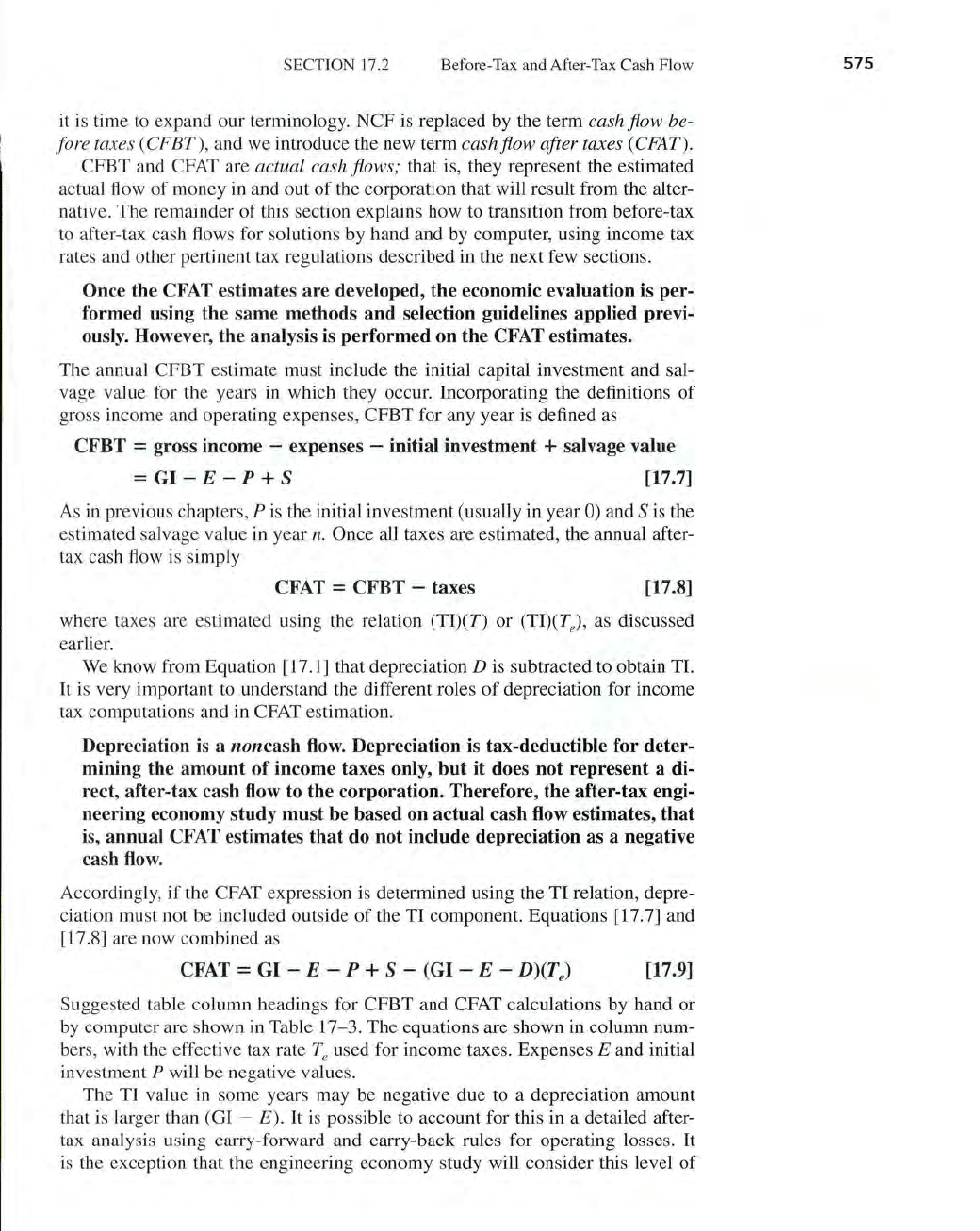
SECTION 17.2 Before-Tax and After-Tax Cash Flow
it is time
to
expand our terminology. NCF is replaced by the term cash flow be-
fore taxes (CFBT),
and we introduce the new term
cashflow
after taxes (CFAT).
CFBT and CFAT are actual cash flows; that is, they represent the estimated
actual flow
of
money
in
and out
of
the corporation that will result from the alter-
native. The remainder
of
this section explains how
to
transition from before-tax
to
after-tax cash flows for solutions by hand and by computer, using income tax
rates and other pertinent tax regulations described in the next few sections.
Once the CFAT estimates
are
developed, the economic evaluation is per-
formed using the same methods
and
selection guidelines applied previ-
ously. However, the analysis is
performed
on the CFAT estimates.
The annual CFBT estimate must include the initial capital investment and sal-
vage value for the years in which they occur. Incorporating the definitions
of
gross income and operating expenses, CFBT for any year is defined
as
CFBT = gross income - expenses - initial investment + salvage value
=
GI
-E
- P + S
[17.7]
As
in previous chapters, P is the initial investment (usually in year 0) and S is the
estimated salvage value in year
n.
Once all taxes are estimated, the annual after-
tax cash flow
is
simply
CFAT = CFBT - taxes
[17.8]
where taxes are estimated using the relation
(TI)(T)
or
(TI)(T
e
),
as
discussed
earlier.
We
know from Equation [17.1] that depreciation D is subtracted to obtain TI.
It is very important to understand the different roles
of
depreciation for income
tax computations and in
CFAT
estimation.
Depreciation
is
a noncash
flow.
Depreciation is tax-deductible for deter-
mining the
amount
of
income taxes only,
but
it
does not represent a di-
rect, after-tax cash flow to the corporation. Therefore, the after-tax engi-
neering economy study must be based on actual cash flow estimates,
that
is,
annual
CFAT estimates
that
do not include depreciation as a negative
cash
flow.
Accordingly, if the
CFAT
expression is determined using the TI relation, depre-
ciation must not be included outside
of
the TI component. Equations [17.
7]
and
[17.8] are now combined
as
CFAT =
GI
- E - P + S - (GI - E -
D)(T
e) [17.9]
Suggested table column headings for CFBT and
CFAT
calculations by hand or
by
computer are shown
in
Table 17-3. The equations are shown in column num-
bers, with the effective tax rate
Te
used for income taxes. Expenses E and initial
investment
P will be negative values.
The TI value in some years may be negative due
to
a depreciation amount
that is larger than (GI -
E). It is possible
to
account for this in a detailed after-
tax analysis using carry-forward and carry-back rules for operating losses.
It
is
the exception that the engineering economy study will consider this level
of
575
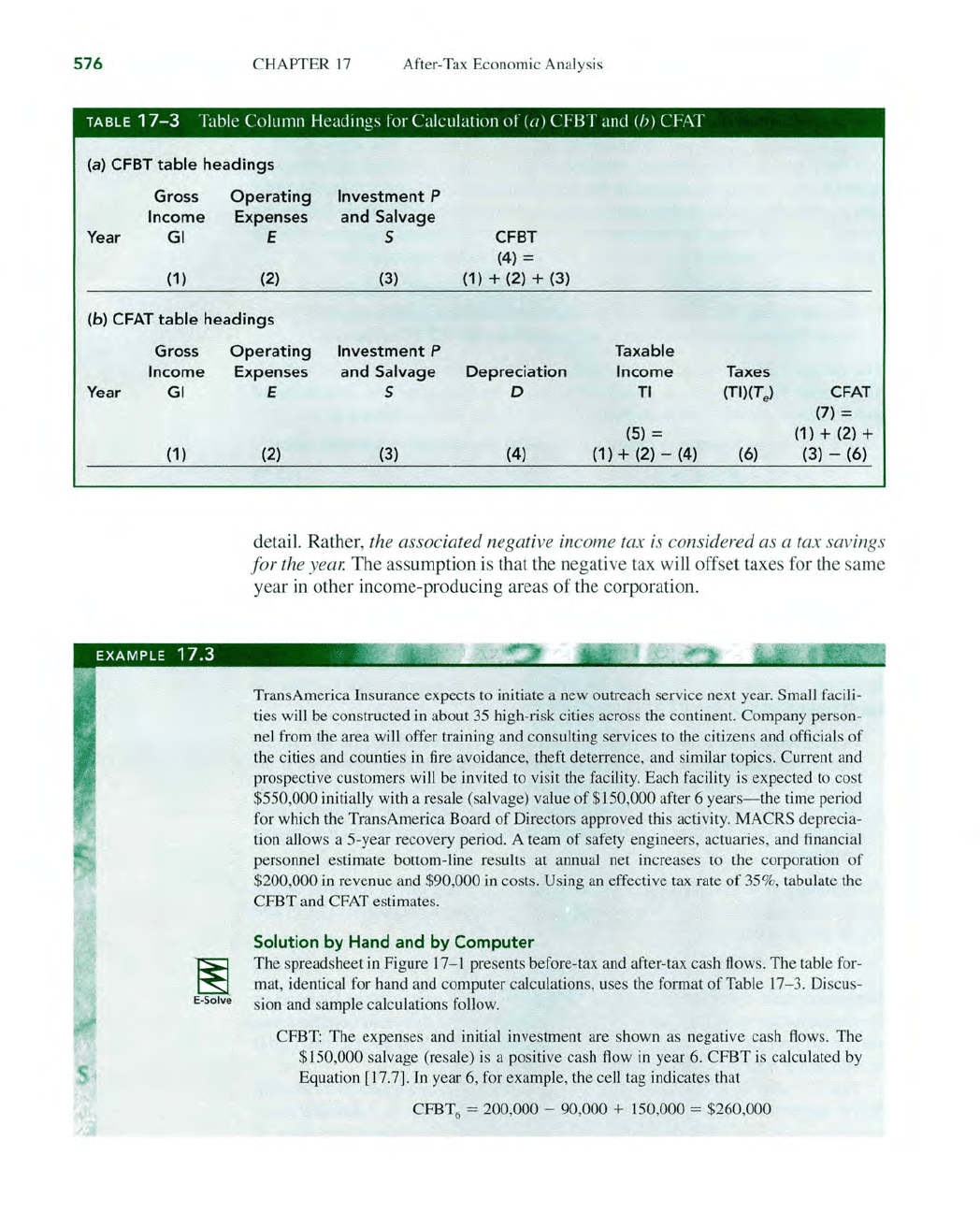
576
CHAPTER 17 After-Tax Economic Analysis
TABLE
17-3
Table Column H
ead
in
gs
for Calculation
of
(({)
CFBT
and
(Ii)
CFAT
(a)
CFBT
table
head
i
ng
s
Gros
s
Ope
r
at
i
ng
Investment P
Income
Expenses
and
Salvage
Year GI
E
5
CFBT
(4) =
(1
)
(2) (3)
(1) +
(2)
+
(3)
(b)
CFAT
table
headings
Year
Gross
Operating
Investment
P Taxable
Income
GI
(1
)
~
E-Sol
ve
Expenses
and
Salvage
Depreciat
i
on
Income Tax
es
E 5
D
TI
(TI)(T
e
)
C
FAT
(7) =
(5) =
(1
) + (2) +
(2)
(3)
(4)
(1) + (2) - (4)
(6)
(3)
-
(6)
detail. Rather, the associated negative
in
come tax is considered as a
ta
x savings
for the
year.
The assumption is that
th
e negative tax will offset taxes for the same
year in other income-producing areas
of
the corporation.
TransAmerica
In
surance
ex
pects to initiate a new outreach service next yea
r.
Sma
ll
facili-
ties will be constructed
in
about 35 high-risk c
iti
es across the continen
t.
Company person-
nel from
th
e area will offer training and consulting services to the citizens and officials
of
the cities and counties in fire avoidance, theft deterrence, and similar topics. Current a
nd
prospective customers will be invited
to
visit the facility. Each facility is expected
to
cost
$550,000 initially with a resale (sa
lv
age) value
of
$150,000 after 6 year
s-
th
e time period
for which the TransAmerica Board
of
Directors approved this activity. MACRS deprecia-
ti
on allows a 5-year recovery period. A team
of
safety engineers, actuaries, and
fi
nancial
personnel estimate bottom-line results at
an
nu
al net increases to the corporation
of
$200,000
in
revenue and $90,000
in
costs. Us
in
g an effective tax rate
of
35
%,
tabulate the
CFBT and CFAT estimates.
Solution
by
Hand
and
by
Computer
The spreadsheet
in
Figure
17
- 1 presents before-tax and after-tax cash flows. The table for-
ma
t,
id
en
ti
cal for hand and computer calc
ul
ation
s,
uses the format
of
Table
17
-3.
Di
scus-
sion and sample calculations foll
ow.
CFBT: The
ex
penses and initial investment are shown
as
negative cash
flow
s.
The
$150,000 salvage (resale) is a positive cash
flow
in
year
6.
CFBT is calculated
by
Equation [17
.7
].
In
year
6,
for example, the cell tag indicates that
CFBT
6
= 200,000 - 90,000 + 150,000 = $260,000
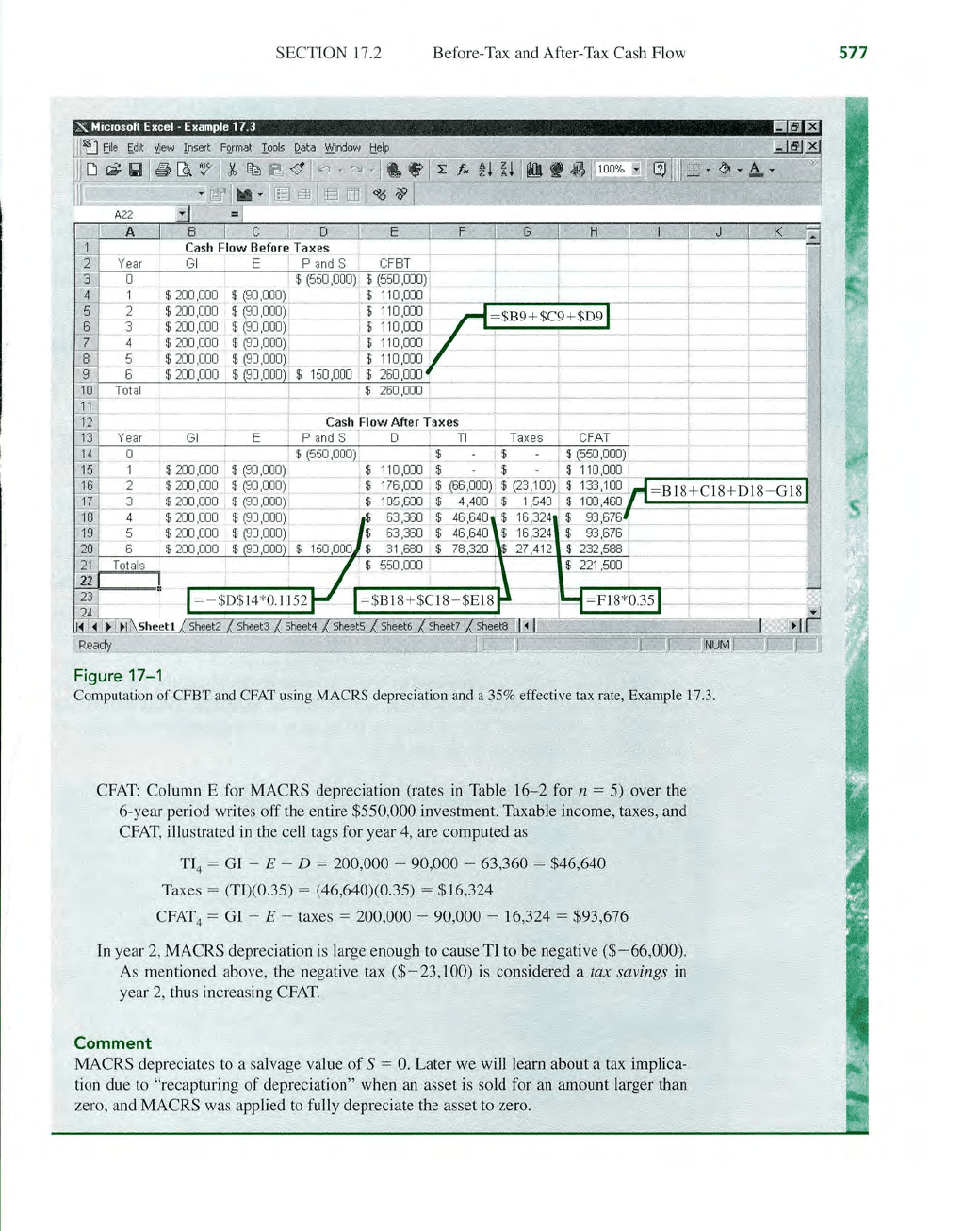
SECTION 17.2 Before-Tax and After-Tax Cash Flow
X Microsoll EHcel - EHample 17.3
Ii!!III'.ii1D
Ye
ar
o
1
2
3
GI
Figure 17-1
Computation
of
CFBT and CFAT using MACRS depreciation and a 35% effective tax rate, Example
17
.3.
CFAT:
Column E for MACRS depreciation (rates in Table 16-2 for n = 5) over the
6-year period writes off the entire
$550,000 investment. Taxable income, taxes, and
CFAT,
illustrated
in
the cell tags for year 4, are computed
as
TI4 = GI - E - D = 200,000 - 90,000 - 63,360 = $46,640
Taxes
= (TI)(0.35) = (46,640)(0.35) = $16,324
CFAT
4
=
Gl
- E - taxes = 200,000 - 90,000 - 16,324 = $93,676
In
year 2, MACRS depreciation
is
large enough
to
cause TI to
be
negative
($-66,000).
As
mentioned above, the negative tax
($-23,100)
is
considered a tax savings
in
year 2, thus increasing
CFAT.
Comment
MACRS depreciates
to
a salvage value
of
S =
O.
Later we will learn about a
tax
implica-
tion due
to
"recapturing
of
depreciation" when an asset is sold for
an
amount larger than
zero, and
MACRS was applied
to
fully depreciate the asset
to
zero.
577
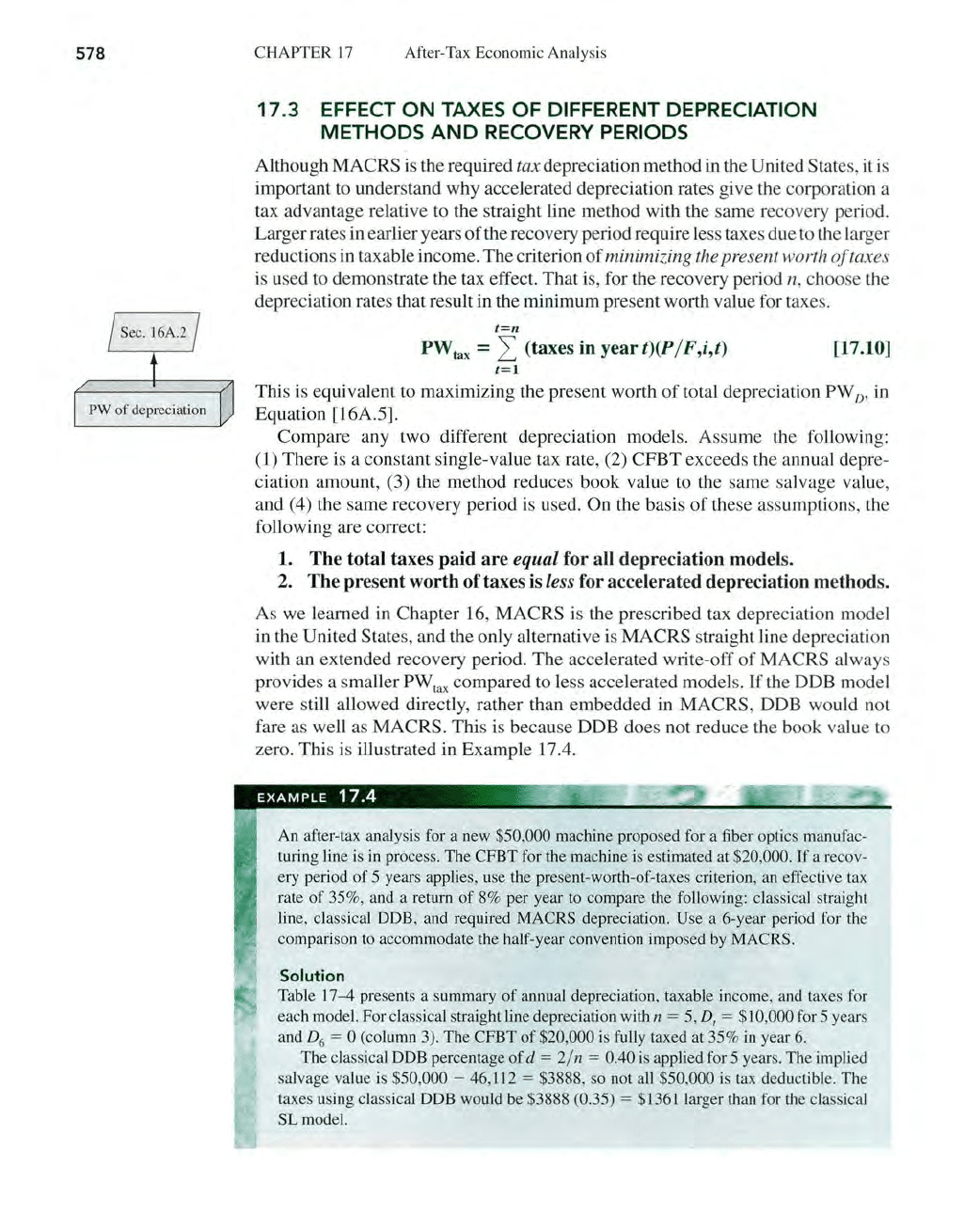
578
CHAPTER
17
After-Tax Economic Analysis
17.3
EFFECT
ON
TAXES
OF DIFFERENT DEPRECIATION
METHODS
AND
RECOVERY PERIODS
Although MACRS is the required tax depreciation method in the United States, it is
important to understand why accelerated depreciation rates give the corporation a
tax advantage relative to the straight line method with the same recovery period.
Larger rates in earlier years
of
the recovery period require less taxes due to the larger
reductions in taxable income. The criterion
of
minimizing the prese
nt
worth a
/ta
xes
is used to demonstrate the tax effect. That is, for the recovery period n, choose the
depreciation rates that result in the minimum present worth value for taxes.
I=n
PW
tax = I (taxes in
year
t)(P
/ F
,i
,
t)
[17.10]
1=1
This is equivalent to maximizing the present worth
of
total depreciation PW D'
in
Equation [16A.S].
Compare any two different depreciation models. Assume the following:
(1) There is a constant single-value tax rate, (2) CFBT exceeds the annual depre-
ciation amount,
(3) the method reduces book value to the same salvage value,
and (4) the same recovery period is used.
On the basis
of
these assumptions, the
following are correct:
1. The total taxes paid
are
equal for all depreciation models.
2.
The present worth
of
taxes
is
less for accelerated depreciation methods.
As we learned in Chapter 16, MACRS
is
the prescribed tax depreciation model
in the United States, and the only alternative is MACRS straight line depreciation
with an extended recovery period.
The
accelerated write-off
of
MACRS always
provides a smaller
PW
l
ax
compared to less accelerated models.
If
the DDB model
were still allowed directly, rather than embedded in MACRS, DDB would not
fare as well as MACRS. This is because DDB does not reduce the book value to
zero. This is illustrated in Example 17.4.
An
after-tax analysis for a new $50,000 machine proposed for a fiber optics manufac-
turi
ng
line is in process. The CFBT for the machine is estimated at $20,000.
If
a recov-
ery period
of
5 years applies, use the present-worth-of-taxes criterion,
an
effective tax
rate
of
35%, and a return
of
8% per year
to
compare the
fo
ll
owing: classical straight
line, classical DDB, and required MACRS depreciation.
Use a 6-year period for the
comparison to accommodate the half-year convention imposed
by
MACRS.
Solution
Table
17--4
presents a summary
of
annual depreciation, taxable income, and taxes for
each model. For classical straight line depreciation with
n = 5,
D{
= $10,000 for 5 years
and
D6
= 0 (column 3). The CFBT
of
$20,000
is
fully taxed at 35%
in
year
6.
The classical DDB percentage
of
d = 2/ n = 0.40
is
applied for 5 years. The implied
salvage value
is
$50,000 - 46,112 = $3888, so not all $50,000 is tax deductible. The
taxes using classical DDB would be $3888 (0.35)
= $1361 larger than for the classical
SLmodel.
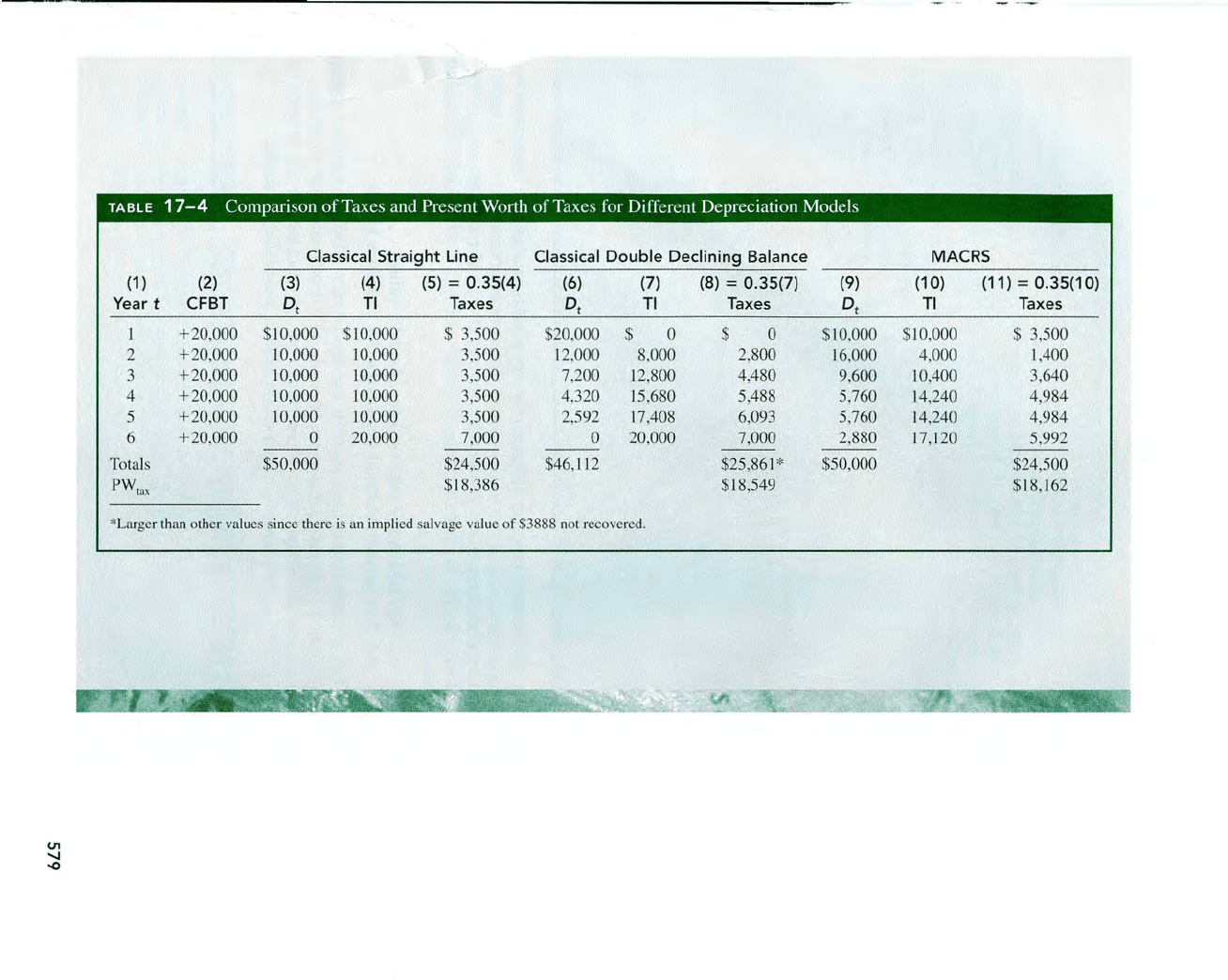
(J1
'-I
-0
Classi
cal
Straight Line Class
ic
al
Double
Declining
Ba
lan
ce
(1 )
(2)
(3) (4)
(5)
= 0.
35(4
)
(6)
(7)
(8)
=
0.35(7
)
Year t CFBT D
t
TI Taxes
D
t
TI
Taxes
+20,000 $10,000 $10,000 $ 3,500 $20,000
$ 0
$
0
2 + 20,000
10
,000 10,000 3,500
12
,000
8,000
2,800
3
+ 20,000
10
,000
10
,000 3,500 7,200
12
,8
00
4,480
4 + 20,000
10
,000 10,000 3,500 4
,3
20
15
,68
0
5,488
5
+2
0,000 10,000 10,000 3,500
2,592
17
,4
08
6,093
6
+2
0,000
0
20,000
7,000
0
20,000
7,000
Totals $50,000 $24,500 $46,
Jl2
$25,861*
PW,
ax
$18,386
$18,549
*Larger than other values since there is an implied salvage val
ue
of
$3888 not recovered.
MACRS
(
9)
(10)
(11) = 0.
35(10)
D
t
TI Taxes
$10,000
$10,000
$ 3,500
16
,000 4,000
1,400
9,600
10
,400
3,640
5,760 14,240
4,984
5,760 14,240 4,984
2,880
17
,120 5,992
$50,000
$24,500
$]8,162

580
CHAPTER
17
After-Tax Economic Analysis
MACRS writes off the $50,000
in
6 years using the rates
of
Table
16
-
2.
Total taxes
are
$24,500, the same as for classical SL depreciation.
The annual taxes (columns 5,
8,
and
11)
are accumulated year by year
in
Fig-
ure
17
-2.
Note the pattern
of
the curves, especially the lower total taxes relative to
th
e
SL model after year 1 for MACRS and
in
years 1 through 4 for
DDB
. These higher tax
values for SL cause
PW
tax
for SL depreciation to be larger. The PW
tax
values at the bot-
tom
of
Table
17-4
are calculated using Equation [17.10]. The MACRS PW
tax
value
is
the smallest at $18,162.
25,000
20,000
""
vl
<t.)
x
15,000
B
-0
~
OJ
0;
E
10,000
;:t
u
u
-0::
5,000
0
MACRS
method
\
/
/
/
SL
method
2
3
Year t
4
5 6
Figure
17-2
Taxes incurred by different
depreciation rates for a
6-year comparison period,
Example 17.4.
To
compare taxes for different recovery periods, change only assumption
fou
at the beginning
of
this section to read: The same depreciation method is applie(
It
can be shown that a shorter recovery period will offer a tax advantage over
longer period using the criterion to minimize
PW
tax
'
Comparison will indic.
lte
that
1.
The total taxes paid are equal for all n values.
2. The present worth
of
taxes is less for smaller n values.
This is why corporations want
to
use the shortest MACRS recovery period
allowed for income tax purposes. Example 17.5 demonstrates these conclusions
for classical straight line depreciation, but the conclusions are correct for
MACRS, or any other tax depreciation method, were others available.
Grupo Grande Maquinarfa, a diversified manufacturing corporation based
in
Mexico,
maintains parallel records for depreciable assets
in
its European operations
in
Germany.
This
is
common for multinational corporations. One set is for corporate use that reflects
the estimated useful life of assets. The second set is for foreign government purposes,
such as depreciation.
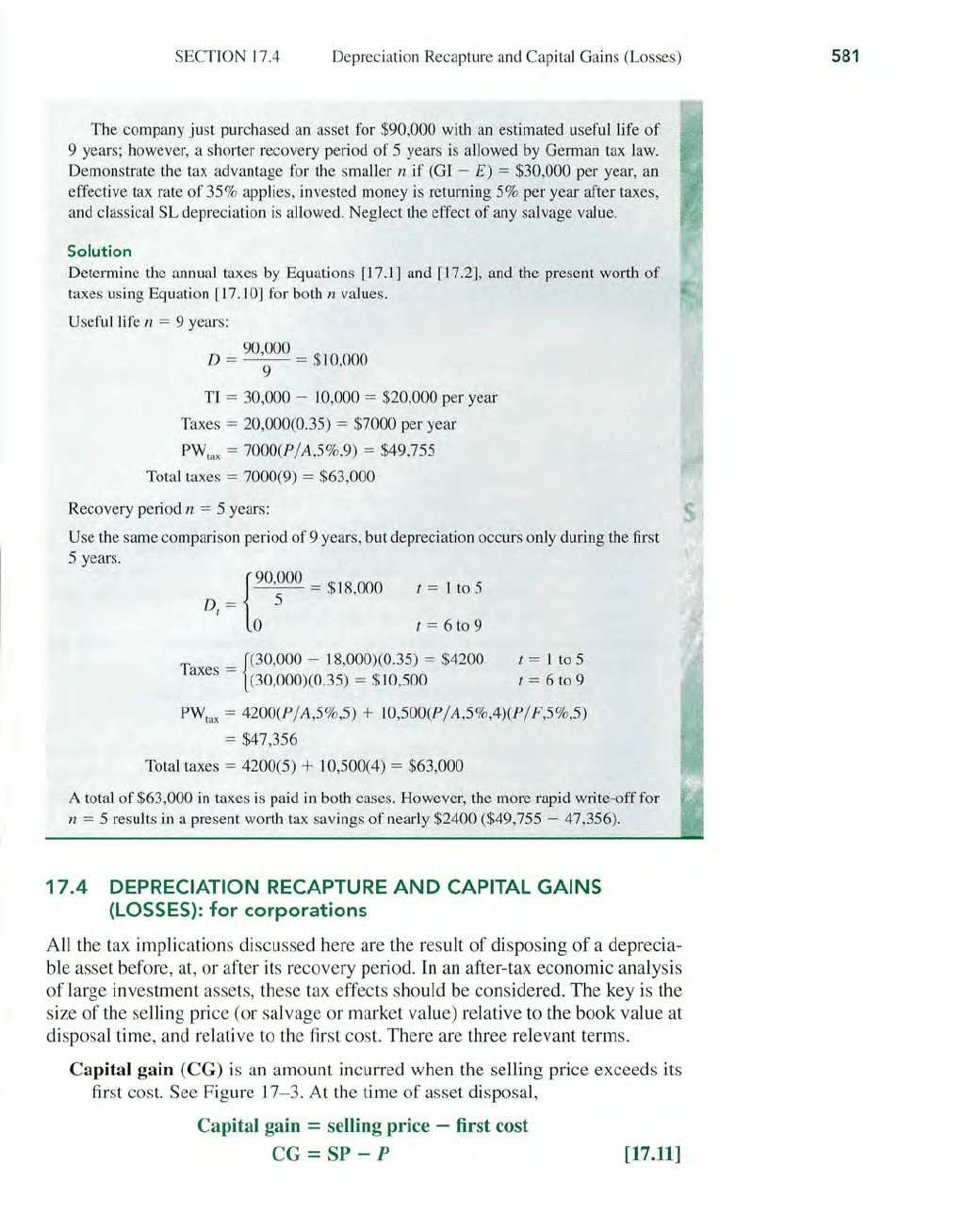
SECTION 17.4 Depreciation Recapture and Capital Gains (Losses)
The company just purchased an asset for
$90,000 with an estimated useful life
of
9 years; however, a shorter recovery period
of
5 years is allowed by German tax law.
Demonstrate the
tax
advantage for the smaller n
if
(GI -
E)
= $30,000 per year, an
effective tax rate
of
35% applies, invested money is returning 5% per year after taxes,
and classical SL depreciation
is
allowed. Neglect the effect
of
any salvage value.
Solution
Determine the annual taxes
by
Equations [17.1] and [17.2], and the present worth
of
taxes using Equation [17.10) for both n values.
Useful life
n = 9 years:
D = 90,000 = $10 000
9 '
TI = 30,000 - 10,000 = $20,000 per year
Taxes
= 20,000(0.35) = $7000 per year
PW
ta
x
= 7000(P/A,5%,9) = $49,755
Total taxes
= 7000(9) = $63,000
Recovery period n = 5 years:
Use the same comparison period
of
9 years, but depreciation occurs only during the first
5 years.
{
90,000
= $18,000
D = 5
I
o
t = 1 to 5
t = 6 to 9
T - {(30,000 -
18
,000)(0.35) = $4200
axes - (30,000)(0.35) = $10,500
t = 1 to 5
t = 6 to 9
PW
tax
= 4200(P / A,5%,5) + 1O,500(P /
A,5%,4)(P/
F,5%,5)
= $47,356
Total taxes
= 4200(5) + 10,500(4) = $63,000
A total
of
$63,000 in taxes
is
paid in both cases. However, the more rapid write-off for
n = 5 results
in
a present worth tax savings
of
nearly $2400 ($49,755 - 47,356).
17.4
DEPRECIATION RECAPTURE
AND
CAPITAL GAINS
(LOSSES):
for
corporations
All the tax implications discussed here are the result
of
disposing
of
a deprecia-
ble asset before, at, or after its recovery period. In an after-tax economic analysis
of
large investment assets, these tax effects should be considered. The key is the
size
of
the selling price (or salvage or market value) relative to the book value at
disposal time, and relative
to
the first cost. There are three relevant terms.
Capital
gain (CG)
is
an amount incurred when the selling price exceeds its
first cost. See Figure
17
- 3. At the time
of
asset disposal,
Capital
gain
= selling
price
- first cost
CG
=
SP
- P
[17.11]
581
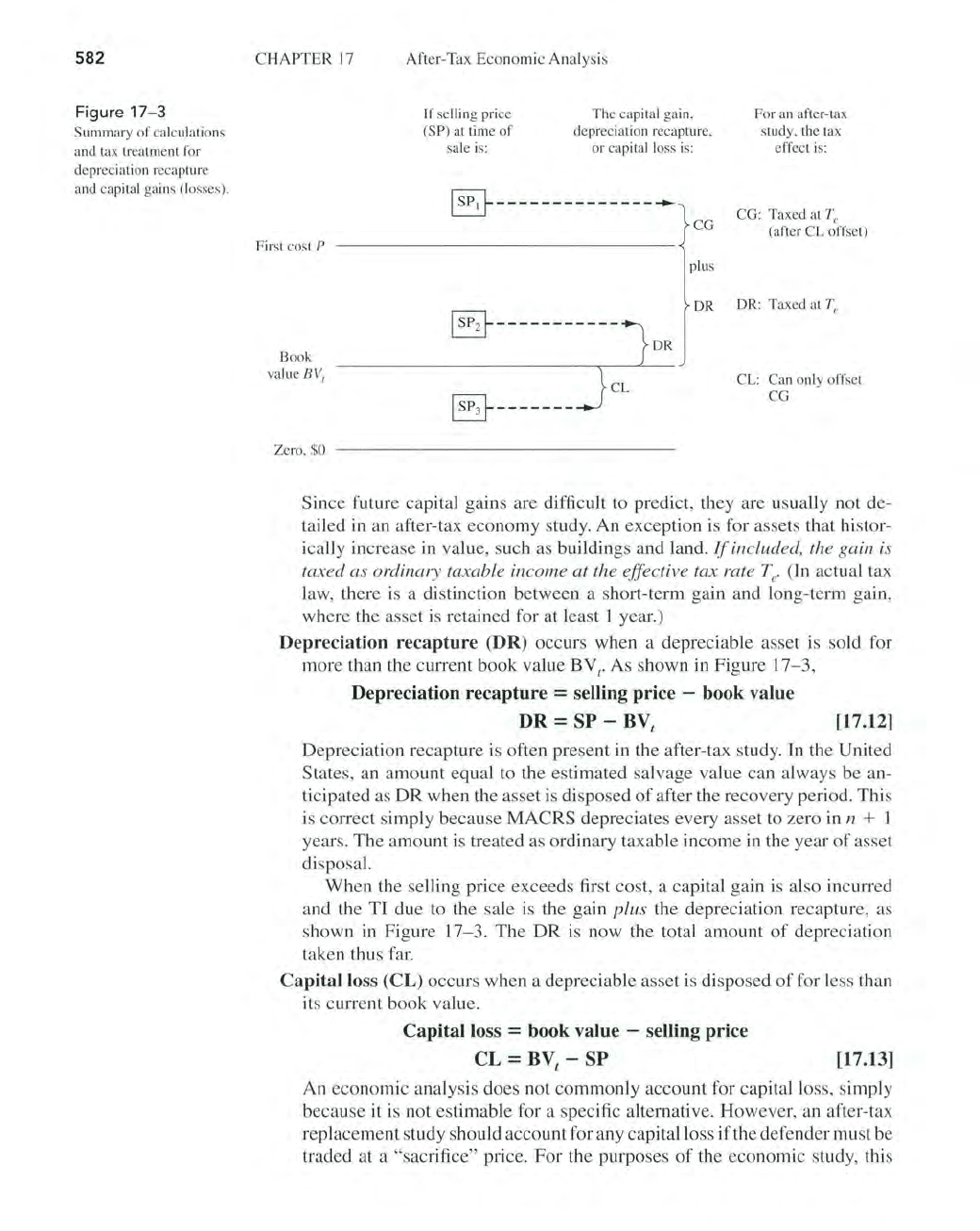
582
Fi
gur
e 17
-3
Summ
ary of c
al
culations
and tax treatment for
depr
ec
iation recapture
and capital gains (losses).
CHAPTER
17
First cost P
Book
value
BV,
Ze
ro, $0
After-Tax
Economic
Analysis
If selling pri
ce
(
SP
) at time
of
sale is:
Th
e capital gain,
depr
ec
iation re
capture
,
or
capital loss is:
~--------------~
CG
plus
DR
For an after-tax
study, the tax
effect is:
CG: Taxed
at
Te
(after
CL
off
set)
DR: Taxed at
Te
CL: Can only offset
CG
Since
future capital gains are difficult to predict, they are usually not de-
tailed
in
an after-tax
economy
study. An exception is for assets that histor-
ically increase in value, such as buildings and land.
If
included,
th
e gain is
ta
xe
d as ordinary taxable inc
om
e
at
the effective tax rate Te' (In actual tax
law, there
is
a distinction between a short-term gain and long-term gain,
where the asset
is
retained for at least 1 year.)
Depreciation
recapture
(DR) occurs when a depreciable asset is sold for
more than the current
book
value
BY
r
As
shown
in
Figure
17
- 3,
Depreciation
recapture
= selling price - book value
DR
= SP - BV
t
[17.12]
Depreciation recapture is often present
in
the after-tax study. In the United
States, an
amount
equal to the estimated salvage value can always be an-
ticipated as DR when the asset is disposed
of
after the recovery period. This
is correct simply because
MACRS
depreciates every asset to zero
in
It
+ I
years.
The
amount is treated as ordinary taxable
income
in
the year
of
asset
di
sposal.
When the selling price exceeds first cost, a capital gain is also incurred
and the TI due to the sale is the gain plus the depreciation recapture, as
shown
in
Figure 17-3.
The
DR
is
now the total amount
of
depreciation
taken thus far.
Capital loss (CL) occurs when a depreciable asset is disposed
of
for less than
it
s current book value.
Capital
loss = book value - selling price
CL
= BV
t
-
SP
[17.13]
An economic analysis does not commonly account for capital loss, simply
because it is not estimable for a specific alternative.
However
, an after-tax
replacement study should account for any capital loss
if
the defender must be
traded at a "sacrifice" price.
For
the purposes
of
the economic study, this
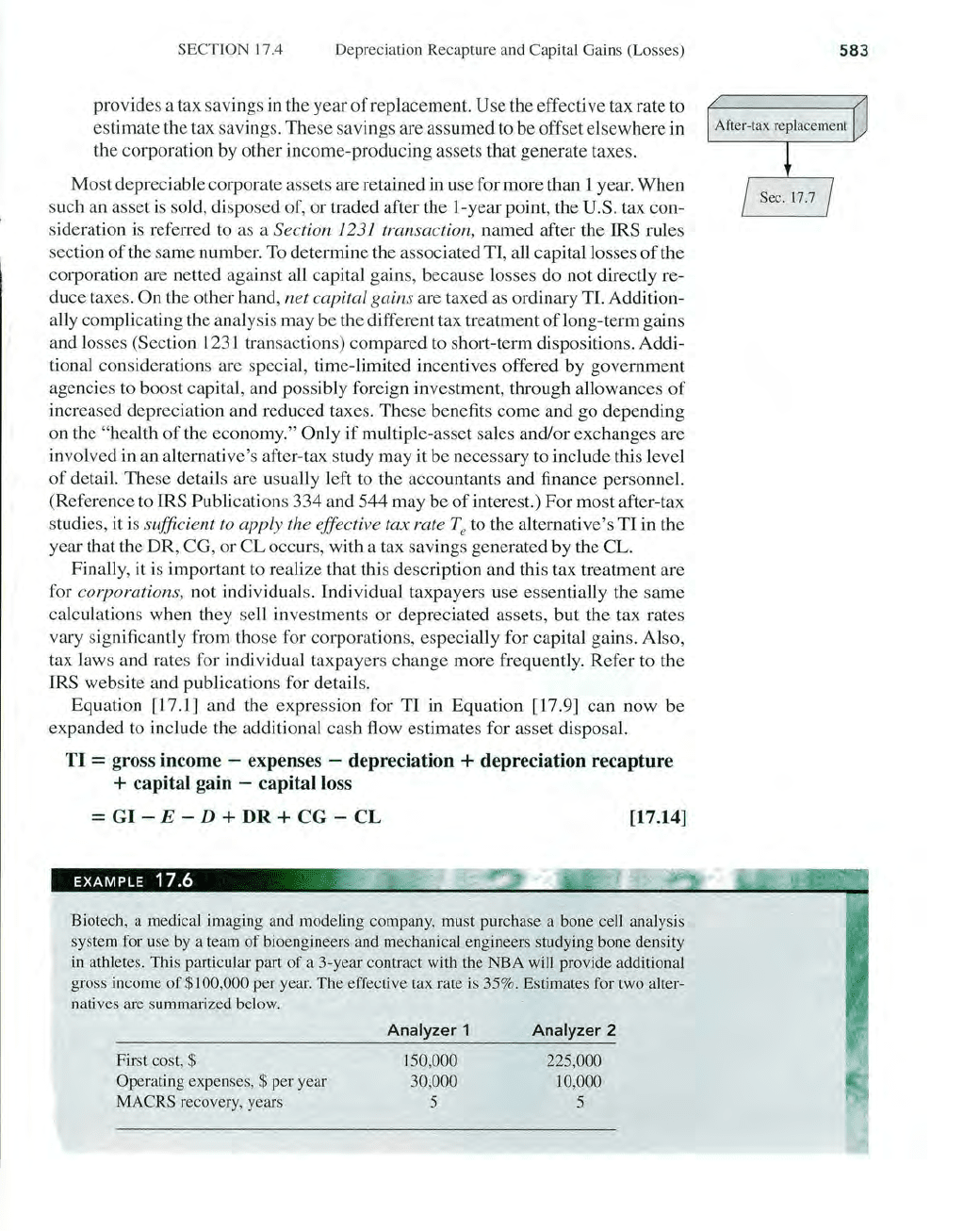
SECTION 17.4
Depreciati
on
Recapture and Capital Gains (Losses)
provides a tax savings in the year
of
replacement. Use the effecti ve tax rate to
esti mate
th
e tax savings. These savings are assumed to be offset elsewhere in
th
e corporation
by
other income-producing assets that generate taxes.
Most depreciable corporate assets are retained in use for more than 1 year. When
such an asset is sold, disposed of, or traded after the I-year point, the
U.S. tax con-
sideration is referred to as a
Section 1231 transaction, named after the IRS rules
section
of
the same number.
To
determine the associated TI, all capital losses
of
the
corporation are netted against all capital gains, because losses do not directly re-
duce taxes.
On the other hand, net capital gains are taxed as ordinary TI. Addition-
ally complicating the analysis may be the different tax treatment oflong-term gains
and losses (Section 1231 transaction
s)
compared to short-term dispositions. Addi-
tional considerations are special, time-limited incentives offered by government
agencies to boost capital, and possibly foreign investment, through allowances
of
increased depreciation and reduced taxes. These benefits come and go depending
on the
"health
of
the economy." Only
if
multiple-asset sales and/or exchanges are
involved in
an
alternative's after-tax study may it be necessary to include this level
of
detail. These details are usually left to the accountants and finance personnel.
(Reference to IRS Publications 334 and 544 may be
of
interest.) For most after-tax
studies, it is
sufficient
to
apply the effective tax rate
Te
to
the alternative's
TI
in the
year that the
DR
, CG, or
CL
occurs, with a tax savings generated by the CL.
Finally, it is important to realize that this description and this tax treatment are
for
corporations, not individuals. Individual taxpayers use essentially the same
calculations when they sell investments or depreciated assets, but the tax rates
vary significantly from those for corporations, especially for capital gains. Also,
tax laws and rates for individual taxpayers change more frequently. Refer to the
IRS website and publications for details.
Equation
[17.1] a
nd
the expression for
TI
in Equation [17.9] can now be
expanded to include the additional cash flow estimates for asset disposal.
TI
=
gross
income
-
expenses
-
depreciation
+
depreciation
recapture
+
capital
gain
-
capital
loss
= GI - E - D +
DR
+
CG
- CL [17.14]
EXAMPLE
17.6
'
Biotech, a medical imaging and modeling company, must purchase a bone cell analysis
system for use
by
a team
of
bioengineers and mechanical engineers studying bone density
in athletes. This particular part
of
a 3-year contract with the NBA will provide additional
gross income
of
$100,000 per year. The effective tax rate is 35%. Estimates for two alter-
natives are summarized below.
First cost, $
Operating expenses, $ per year
MACRS recovery, years
Analyzer 1
150,000
30,000
5
An
alyzer 2
225,000
10,000
5
583
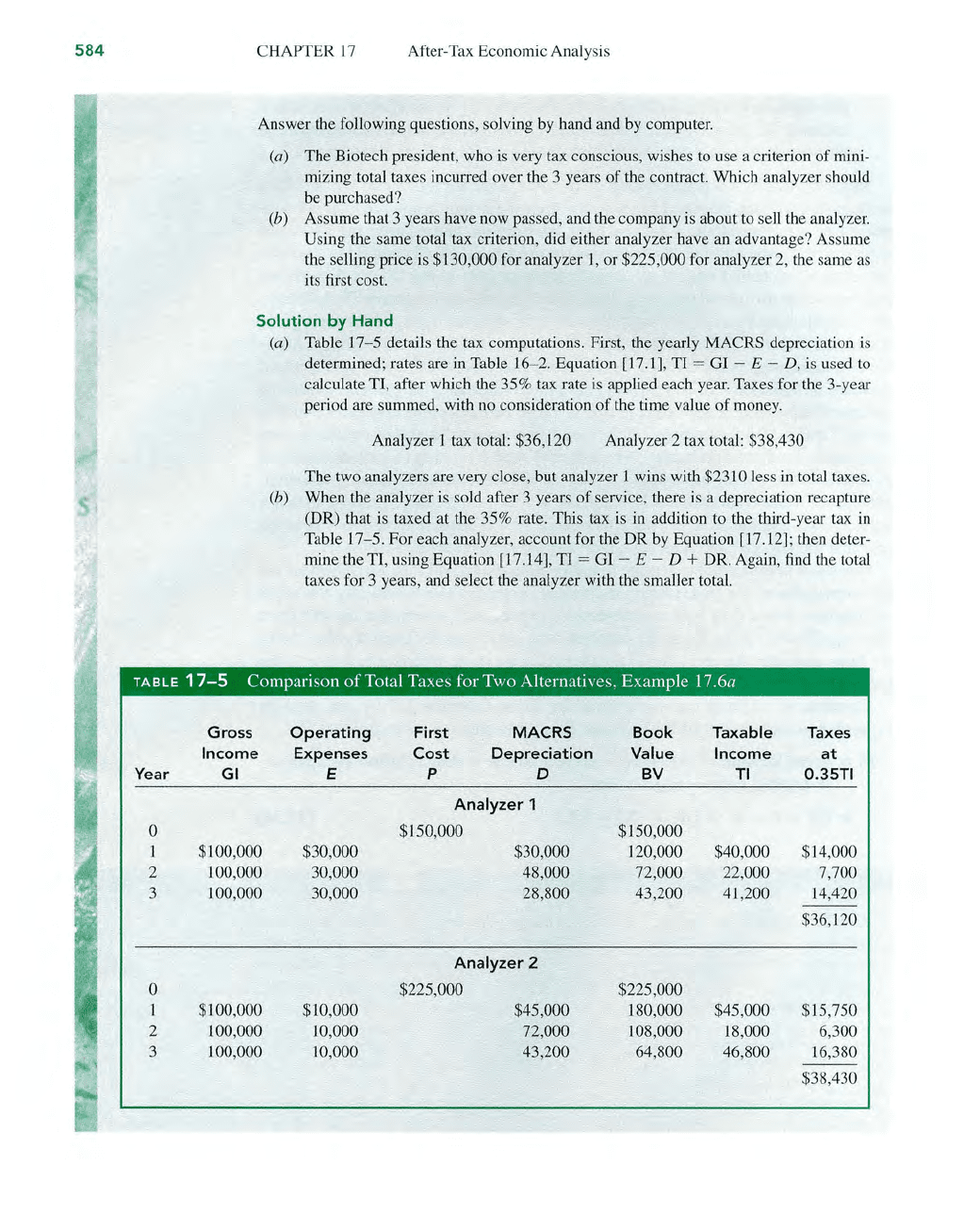
584
CHAPTER
17
After-
Tax
Economic Analysis
Answer the following questions, solving by hand and
by
computer.
(a) The Biotech president, who is very tax conscious, wishes to use a criterion
of
mini-
mizing total taxes incurred over the 3 years
of
the contract. Which analyzer should
be
purchased?
(b) Assume that 3 years have now passed, and the company is about to sell the analyzer.
Using the same total tax criterion, did either analyzer have an advantage? Assume
the selling price
is
$130,000 for analyzer
J,
or $225,000 for analyzer 2, the same
as
its first cost.
Solution by Hand
(a) Table
17
- 5 details the tax computations. First, the yearly MACRS depreciation is
determined; rates are in Table 16- 2. Equation [17.1], TI
=
OJ
- E - D, is used
to
calculate TI, after which the 35% tax rate is applied each year. Taxes for the 3-year
period are summed, with
no
consideration
of
the time value
of
money.
Analyzer 1 tax total: $36,120 Analyzer 2 tax total: $38,430
The two analyzers are very close, but analyzer 1 wins with $2310 less
in
total taxes.
(b) When the analyzer is sold after 3 years
of
service, there
is
a depreciation recapture
(DR) that is taxed at the 35% rate. This tax is
in
addition to the third-year tax
in
Table 17-5. For each analyzer, account for the DR by Equation [17.12];
th
en deter-
mine the TI, using Equation [17.14J, TI
=
OJ
- E - D + DR. Again,
find
the total
taxes for 3 year
s,
and select the analyzer with the smaller total.
TABLE
17-5
Comparison
of
Total Taxes for Two Alternatives, Example
17.6a
Gross
Operating
First
MACRS Book Taxable Taxes
Income
Expenses Cost Depreciation Value Income
at
Year GI E
P D
BV
TI
O.35TI
Analyzer 1
0 $150,000 $150,000
1 $100,000
$30,000
$30,000
120,000
$40,000 $14,000
2 100,000
30,000
48,000 72,000 22,000 7,700
3 100,000 30,000 28,800 43,200
41
,200
14
,4
20
$36,120
Analyzer 2
0 $225,000 $225,000
$100,000 $10,000 $45,000 180,000 $45,000
$15,750
2
100,000 10,000 72,000 108,000 18,000 6,300
3
100,000 10,000 43,200 64,800 46,800 16,380
---
$38,430
